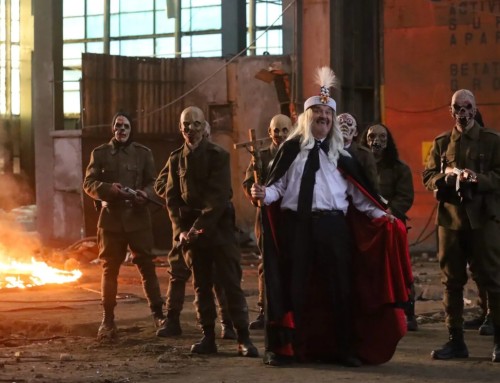Martin Scorsese’s “The Irishman” is truly a triumphant work of ambition and grandeur, and not just because of its groundbreaking de-aging digital effects that transform its older lead actors back into much younger looking men. While that has been the main spotlight of the films notoriety, as well as being an enormously expensive project that exceeded 140 million dollars–which is unorthodox for any project nowadays that isn’t a superhero movie, Scorsese’s latest ambitious endeavor ended up being financed and distributed by Netflix instead of by any major Hollywood studio. What makes “The Irishman” truly an extraordinary accomplishment is its melancholic meditation and muted expedition on the isolation of what organized crime ultimately leaves on the individual.
This is a film that takes the viewer into a long itinerary about the conjoined forces between youth and time, age and corruption, regret and ultimately redemption. Clocking in at exactly 3 1/2 hours, the Frank Sheeran-Jimmy Hoffa sprawling true story saga may be long, but the journey is advantageous. Not only is this the first collaboration between Martin Scorsese and his erstwhile fellow actor Robert De Niro have had together since the 1995 masterpiece “Casino”, the film also marks the first time Scorsese has ever worked with Al Pacino. Joe Pesci also returns on the screen for the first time in years, and of course each of these iconic actors get to look much younger with their digital face-lifts.
Despite all the buzz and hoopla, “The Irishman” is ultimately an elegiac chronicle of crime about the solitude and emptiness the organized crime lifestyle brings. Just as Scorsese’s previous film “Silence” examined the gulf between faith and conviction, Scorsese crafts a versatile, varied work of art that ranks up there with “Silence” and “The Last Temptation of Christ” as being one of Scorsese’s most mature and contemplative efforts to date. Structured around the process of regret and the passage of time, “The Irishman” opens in a retirement home of Frank Sheeran’s (De Niro) expressing his reflections and memories of his staggering mafia career as the song “The Still of the Night” by the Five Satins ballads in the background, the film starts off with Sheeran apprising the audience of the burden the organized lifestyle engraves on the soul during the course of his career.
“The Irishman” theoretically solves the enigma of Teamster’s Union leader and his bizarre disappearance in the summer of 1975. Based on the 2004 book by Charles Brandt, “I Heard You Paint Houses”, that is based on Sheeran’s own interviews Brandt had with him on what led to the disappearance of Hoffa. The book is a collage of confessions of the details in which Sheeran claimed he killed Hoffa at the decree of his crime bosses. Yet Scorsese along with screenwriter Steven Zallian are more interested in Sheeran’s mentee into the organized crime world. Like “Goodfellas” and “Casino”, the film authentically examines how a crime syndicate conducts and operates. The film examines the conflicting moral codes, the double crosses, and even language and code names of the Mafia culture. For example, the usage of the phrase “painting houses” is just a term for doing a hit on someone.
Despite the films unexpected melancholic and somber tone, the first half of “The Irishman” still plays out like “Goodfellas” and “Casino”. The exuberant energy is still to be found, along with the breezy pacing and vigorous narration. The saga begins in the 1950’s of Sheeran as a union driver, who ends up working under the Bufalino’s, a powerful crime family that is led by Russel Bufalino (Pesci). While Pesci delivers his combative peculiarities, yet there is something very restraint and even delicate to his performance here than his previous iconic characters. “The Irishman” changes tonally once the inevitable victim Jimmy Hoffa (Pacino) enters the film during the 1960’s, a magnetic Union leader and empowering public speaker that fights for the working class. Hoffa is also a close friend of the Bufalino’s, he requests security which leads to Sheeran protecting him and becoming his right hand man. The two men become close friends, in which their bond leads both men down a journey of loyalty, family, deception, and tragic betrayal. Hoffa eventually falls apart, he is charged, tried, and imprisoned with bribery and other scandals. Hoffa eventually becomes self-destructive and caustic once he is released from prison in 1971 as he starts demanding his old status back. With his populist impertinence and entitlement running amok, Pacino manifests the role of Hoffa as a loose cannon who becomes a complete embarrassment not only to himself, but to his mob associates around him. Pacino is truly extraordinary here, he possibly delivers his greatest performance in decades. Pacino takes his lunacy that often feels like caricature as he transforms these eccentricities with more dimension and despair.
De Niro’s Frank Sheeran is the most tone-downed performance in the film. Frank is the type of man that mostly observes and bottles up his anxieties inside until they just rapture with primal violence. A great moment in the film includes Frank confronting and assaulting a grocery store owner after he disrespects his daughter Peggy, this particular moment shows the primal nature Frank has repressed within. The incident ultimately disconnects and destroys his relationship with Peggy. There have been some criticisms of Paquin having very little dialogue in the film, in fact outside of Josephine Hoffa (Welker White), there is almost a complete absence of women in the saga. All around this is a sprawling saga about history unfolding in a certain time and space that is being generated by very corruptible and violent men. There is a powerful moment of Paquin expressing so much without saying a word as she re-encounters a much older Frank years later at a funeral. During this moment, as Frank is elderly and crippled it feels shattering and heartbreaking in just how Frank’s unscrupulous choices in life created the disconnection with his daughter. It is there where Frank truly feels isolated, somewhere where we all don’t want to be once we become elderly.











I need to see his film ASAP! . Excellent review Robert, thanks for that.
I am curious what your opinion is on using digital facelifts in general? Do see any down side to there use in film?
While the film is groundbreaking in its technique, I hope that it’s not eventually abused or overused. The only small quibble I had about it was the movements of some of the actors. Once we get in a period of Sheeran in his 40’s he confronts a shopkeeper, and the way he kicks him on the ground feels like the agility a much older man. It is the only small misstep in the film, but it was just a great moment in the film that left a greater impact that I easily forgave the discrepancy.
This truly is an extraordinary achievement. I saw it last night at the IFC Center and you could hear a pen drop.
I’m excited to see this but keeping expectations in check. Robert-reading your reply to Patrick, that is something I picked up in the first trailer. The movements of them still look like an old person in the action movement. Regardless, I am excited for the story. Nice review!
I’m very happy to hear this holds up! It opens in my area this weekend.
It was truly a great return to the Scorsese films I watched growing up!
I was so excited and to see so many great actors back on the screen together, Martin Scorsese’s The Irishman , I loved everything about the movie. I do feel it could have been shorten to 3 hours, and the time Robert De Niro beat up the grocery owner, I couldn’t help but to laugh, but besides that it was a great movie and I recommend it.
Robert what a great review, thanks for recommended it, I always look to your recommendation for a great movie to watch , Yolanda
The Irishman is amazing.
I watched it at the movies on Friday. I’m watching it again today on Netflix. One of the best movies of the year! Pacino is getting an Oscar nomination for his performance
Epic. These actors are the best Then Pacino shows up wow. Really can’t single them out, and De Niro is De Niro.
The film is definitely extraordinary. Scorsese’s new concept of crime relations combines the past of gang crimes into the idea of redemption. The lighting, the dramatic blocks and fantastic acting all came along very well. Excellent film.
This movie was worth the wait! Ever since I heard Joe Pesci came out of retirement for this I was so excited! Fantastic performances from all the actors!
157509 782821baby strollers with high traction rollers really should be a lot safer to use compared to those with plastic wheels- 61355
854620 182337Basically wanna input on couple of general items, The website layout is perfect, the articles is truly great : D. 475719
731127 406849This web site can be a walk-through its the information you wanted concerning this and didnt know who to ask. Glimpse here, and you will undoubtedly discover it. 903048
663618 307180Interesting, but not ideal. Are you going to write a lot more? 560193
678348 681919You may locate two to three new levels inside L . a . Weight loss and any 1 someone is incredibly important. Initial stage may possibly be real melting away rrn the body. lose weight 293784
244815 107734Good day. Quite cool weblog!! Man .. Excellent .. Amazing .. Ill bookmark your site and take the feeds additionallyI am glad to locate numerous valuable info proper here within the post. Thank you for sharing.. 955007
766903 95069quite nice put up, i definitely really like this web internet site, keep on it 618568
Pretty section of content. I just stumbled upon your blog and in accession capital to
assert that I acquire actually enjoyed account your blog posts.
Anyway I will be subscribing to your augment and even I achievement you access consistently fast.
adreamoftrains web hosting reviews
412369 167671hey there i stumbled upon your site searching about the web. I wanted to say I enjoy the appear of issues around here. Maintain it up will save for confident. 717648
201695 18556I definitely enjoyed the method which you explore your experience and perception of the region of interest 322400
299775 585902A person necessarily lend a hand to make severely posts Id state. This is the very first time I frequented your internet page and to this point? I surprised with the analysis you created to make this certain submit extraordinary. Magnificent approach! 41723
Touche. Solid arguments. Keep up the good work.
320314 598045Youre so cool! I dont suppose Ive read anything in this way before. So good to locate somebody by original thoughts on this subject. realy thanks for beginning this up. this fabulous website is one thing that is required on the internet, a person with a bit of originality. beneficial project for bringing a new challenge towards internet! 354282
99425 857604This post gives the light in which we can observe the reality. This really is extremely nice one and gives in-depth details. Thanks for this good post. 2189
215109 906848It is rare knowledgeable folks within this subject, nevertheless, you seem like theres far more you are talking about! Thanks 733913
987749 359172Slide small cooking pot inside the cable to make it easier for you to link the other big wooden bead for the conclude with the cord. 886500
YouTube Bulk Views is the 1 Supplier of Quick and Modest YouTube Views for youtube channels and recordings. Purchase YouTube Views Likes Subscribers
Buying views may seem tempting as a shortcut to increase your video’s visibility, but it can have negative consequences. YouTube has sophisticated algorithms in place to detect fraudulent activity, including artificially inflated view counts. If caught, your channel could face penalties such as account suspension or termination.
Buy YouTube views real from Buyyoutubeviews.org and make your youtube channel grow exponentially. If you are looking to increase the reach of youtube video, you are on the right place.
Buy YouTube views, subscribers, likes, or any other engagement on the platform is against YouTube’s terms of service. YouTube has strict policies against artificially inflating metrics, as it undermines the credibility and fairness of the platform. Engaging in such activities can lead to severe consequences, including the removal of videos, channel suspension, or even permanent termination.